Traditional Cretan Food: From Farm to Table at...
Experience Crete’s slow food philosophy where...
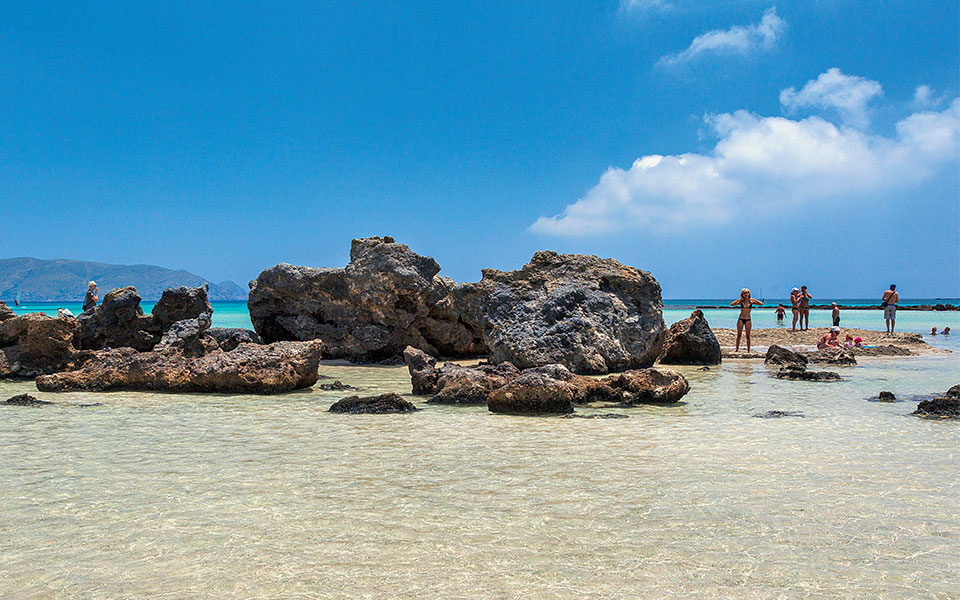
Elafonisi beach
© Perikles Merakos
Planning a trip to Hania? Read the guide below to make sure you don’t miss the best of a region that offers everything from high mountain trails to glorious beaches.
THE ARTISTS’ NEIGHBORHOOD: Not far from the city of Hania is Verekynthos, a village where dozens of artists and craftsmen work year-round and exhibit their creations. You’ll find everything from silversmiths and music instrument makers to ceramicists’ and painters’ studios. (Open Mon-Sat 10.00-16.00; times may vary).
THE HOLY GORGE: A breathtaking experience is in store for you in the Akrotiri area. In Avlaki Gorge, one can witness the evolution of religious customs across the centuries. You can easily access the Aghia Triada (Holy Trinity) Tzagarolon Monastery, built in the 17th century by a family of Venetian and Cretan origin. It’s still a functioning monastery, and its rich heritage spans several centuries (Tel. (+30) 28210.635.72).
Close by is Gouverneto Monastery, or Our Lady of the Angels, built in the 16th century in the style of a Venetian fortress (Tel. (+30) 28210.278.07). There, you can admire the impressive 18th-19th c. narthex, which is full of carved reliefs and grotesque pagan masks. This is where the path through the wild gorge begins. You’ll pass by the chapel of Panaghia Arkoudiotissa, at the same site where the goddess Artemis was worshiped in antiquity, then by the cave of Aghios Ioannis Xenos, or Erimitis (St John the Foreigner or the Hermit), where evidence of an ancient cult has also been found, and arrive at Katholikon Monastery.
The last is a derelict monument, incorporated into the rock-face. Built in the 16th century, it is said that the site was already being used by a monastic community since the 10th century. Cross the massive stone bridge of the gorge and you’ll quickly reach the craggy shore for a refreshing dip (walking time: 30 mins).
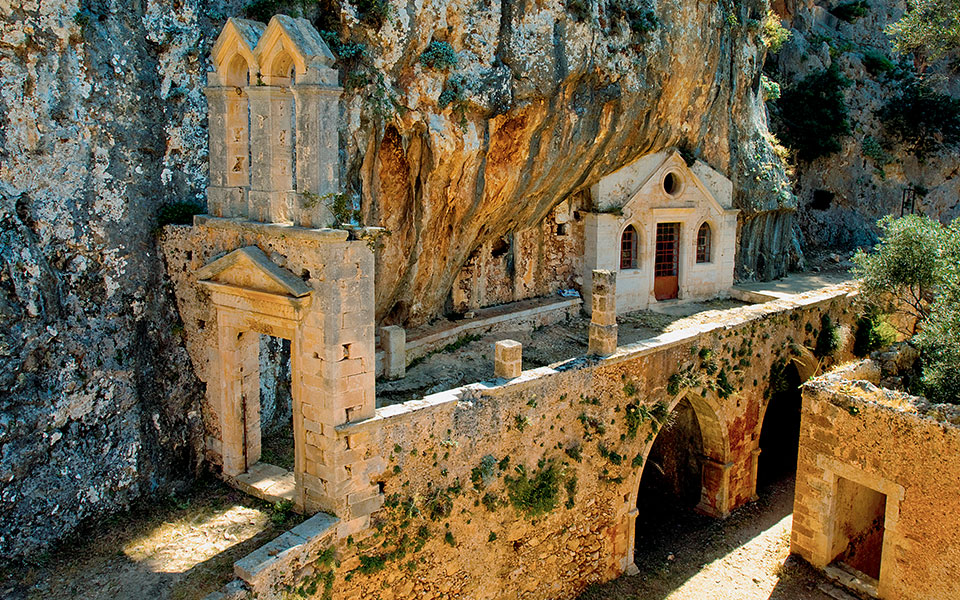
Katholikon Monastery
© Visualhellas.gr
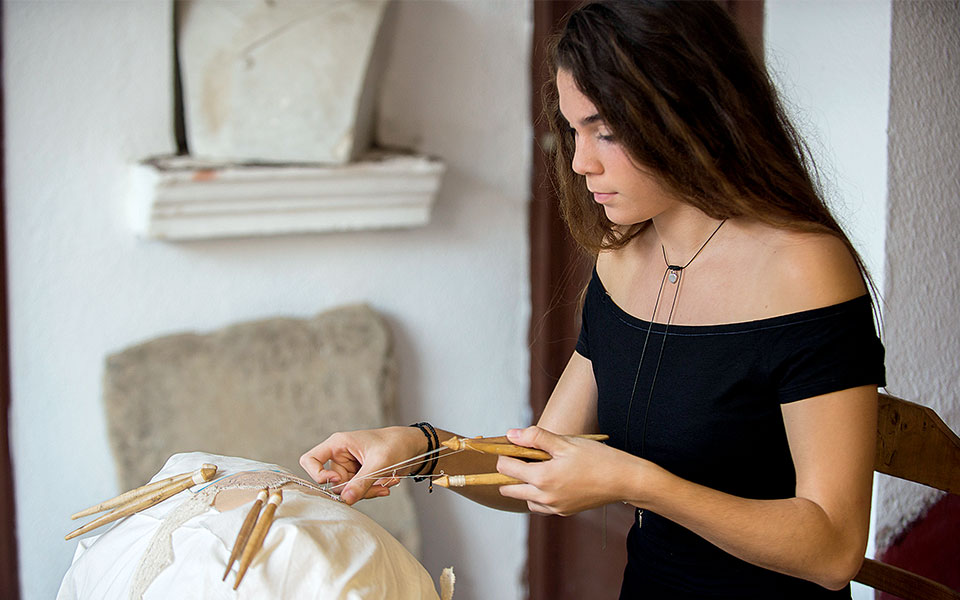
A young embroideress at Gavalohori
© Clairy Moustafellou
UNUSUAL GAVALOHORI: Over the years, hundreds of western European visitors have arrived in the Apokoronas region and decided to stay for good. The tranquil landscape with olive groves and beautiful villages, as well as the easy access to the sea and to the cities of Hania and Rethymno, was reason enough. In the village of Gavalohori alone, 40 of the 200 residents are from abroad.
Walk along the narrow lanes of this protected settlement, admire the old, colorful houses and, in the afternoon, join the locals at the cafés in the large main square. For the complete Gavalohori experience, visit the well-designed Historical and Folklore Museum (Tel. (+30) 28250.232.22); get acquainted with the traditional embroidery technique of kopaneli at the local women’s cooperative; and have a look at the 24 Venetian wells with their stone-built domes, situated in a verdant stretch of land a little ways out from the village.
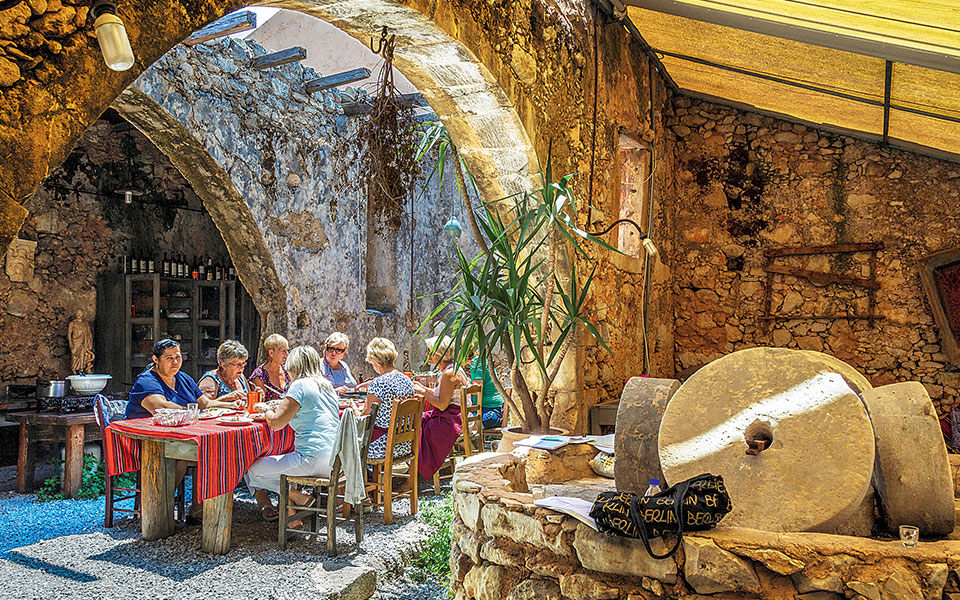
Fabrica Vamos
© Perikles Merakos
VAMOS! When a group of young men with roots in the village of Vamos decided to transform it into an agritourism destination back in 1994, the rest of Greece didn’t even know what sustainable tourism meant. The village, the former capital of the Sfakia region, already had public offices and beautiful grand mansions. The men began by restoring their family homes, transforming them into guesthouses, and building a taverna. None of them took the matter too seriously, and this is possibly the reason for their success. They did everything themselves: even doctors and civil engineers ended up being tasked with peeling potatoes!
The young men grew up and each now has his own business, while new members are being added all the time. Today, Vamos is a beautiful village with guesthouses for every budget, the same taverna with excellent lamb roasted in a wood-fired oven, and an agency for agritourism activities. Every year, the famous Jazz in July Festival takes place, while the restored factory of the village, Fabrica, hosts cultural events and courses.
UPCYCLING: In his workshop in the village of Kokkino Horio, Andreas Tzombanakis creates works of art out of recycled blown glass, using empty bottles as raw material. Although his output has dropped as he has advanced in years, the objects he has been making during an entire lifetime continue to travel across the world (Tel. (+30) 28250.311.94).
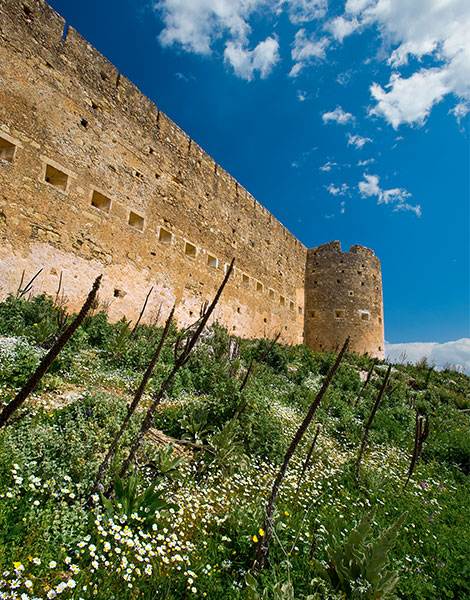
Aptera
© Clairy Moustafellou
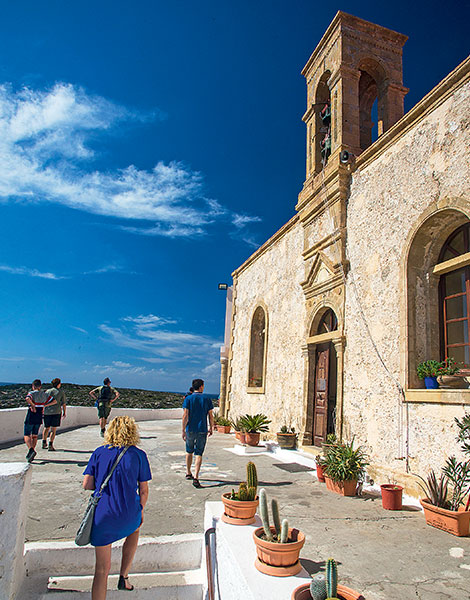
Chrysoskalitissa Monastery
AMAZING RUINS: Originally a Minoan settlement mentioned in Late Bronze Age Linear B tablets, Aptera lay within the domain of the more-powerful Kydonia (Hania), 12km to the west. Reestablished in the 7th century BC, it grew into an enormous, fortified city whose walls extend more than 3km. Aptera flourished in Classical and especially Hellenistic times, eventually becoming a Roman and Byzantine town.
Set on a prominent hill overlooking Souda Bay, the site today offers breathtaking views in all directions, with the Ottoman castles of Aptera and Itzedin lying just to the east. Mythologically, Aptera (“wingless”) gets its name from a musical contest in which the Muses defeated the Sirens, who, stunned by their loss, fell into the sea and became the white islands visible in the bay. Although quarried for building material, the site still impresses, with its fortifications, temples, theater, baths, vaulted cistern, chapels and disused monastery. – JOHN LEONARD
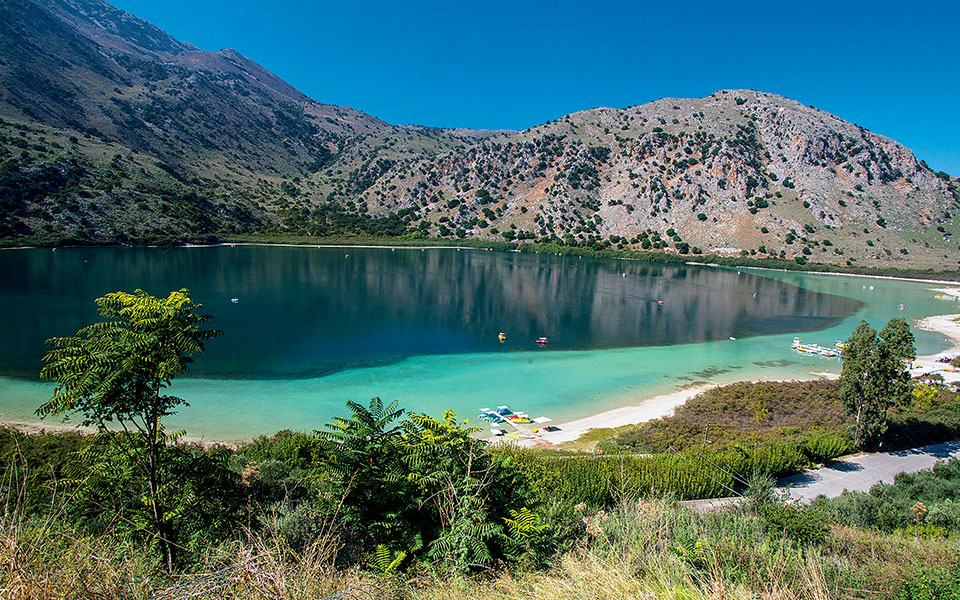
Kourna Lake
© Clairy Moustafellou
PEDAL BOATING: The only natural lake in Crete, Lake Kournas constitutes a point of reference for Hania, since almost every visitor will pass through here to pedal boat on its waters and to eat at the tavernas on its banks. Covering 579 hectares, and with a maximum depth of 22m, it is surrounded by verdant slopes. The mere sight of the waters will stun you.
NATURAL PRODUCTS: Lavender, Cretan dittany, oregano, spearmint and other aromatic herbs are cultivated in mountainside fields without fertilizers, and are then dried and packaged, or used in other preparations at the Cretan Feast workshop, in the village of Macheri. The Kokolakis family will tell you about the small, controlled production, which guarantees a high-quality product, and will show you the impressive method of distilling essential oils. You can find natural beeswax creams, soaps, essential oils, balsamic vinegar infused with essential oils, and more (Tel. (+30) 28250.417.74).
THE SCARS OF WAR: Close to the most touristy part of Hania, with the big hotels and the beach bars of the fashionable strands of Aghia Marina and Platanias, is Maleme, the site of heavy fighting during the Battle of Crete (May 1941). The nearby German Cemetery is the final resting place of 4,465 German soldiers, most of them paratroopers. If you’re wondering how the local people can tolerate a cemetery for onetime invaders, then you might like to know about the legendary grandmother of Maleme, who’d come here to light votive candles, in the hope that some other grandmother would be lighting a candle for her own son, whose body was never returned to her. The Allied Cemetery, located near the port of Souda, contains 1,527 graves of Allied soldiers from the UK, New Zealand, Australia and other countries. Both cemeteries are open to the public.
ARCHAEOLOGISTS FOR A DAY: If you have children, or even for your own interest, do make a stop at the village of Kasteli in Kissamos to visit the Archaeolab, a unique workshop that simulates an archaeological dig. It was created by the archaeologist Koula Borboudaki, and is patented as a global innovation. It has programs aimed at children of all ages, as well as adults and archaeology students. The excavations, and the classification of the finds reflect real archaeological techniques and are performed using real tools. The finds are always related to a specific historical period, which also forms the basis of the relevant discussion. Learning can be fun! (Tel. (+30) 6939.305.668).
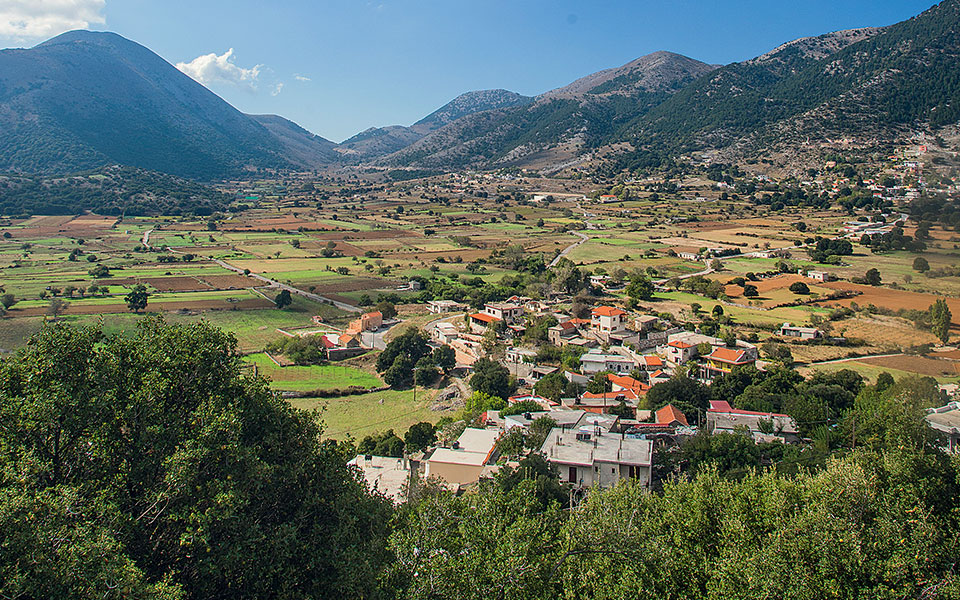
Askyfou Plateau
© Clairy Moustafellou
ASKYFOU PLATEAU: On the way to Sfakia, you will pass through the Askyfou Plateau, with extensive farmland and highly developed livestock farming. On its slopes there are four villages, including Kares, where you can visit the War Museum (Open 09:00-21:00), and Ammoudari, where you can find Ieronymos Gialedakis, a bootmaker specializing in the local stivania (the tall, black, fitted boots of the Cretans); Nektarios’ nice kafeneio, for grilled meat from his own herd; and Lefkoritis Hotel (lefkoritis.com), which organizes hiking events, biking excursions and horseback tours.
THE END OF EUROPE: Welcome to the southernmost boundary of Europe, the island of Gavdos. They say that this is where Calypso kept Odysseus as her captive. The southernmost point is the craggy headland next to Trypiti Beach (accessed by boat or via a path) and it is marked by the sculpture of an oversized chair made by a group of Russian scientists who chose Gavdos as their retreat.
Hundreds of people return to the island year after year, on the ferry from Sfakia or Paleochora, for bohemian vacations on what feels like a place on the very edge of the world. The island has seen some development in recent decades, boasting an organized network of paths and several shops. In wintertime there are no more than a 100 inhabitants, yet in the summer many thousands visit, with most of them spending the night in tents on the beaches of Aghios Ioannis and Sarakiniko (bathing suits optional). Life on the sand dunes requires no more than good company, and this is available in abundance on the island. Tune in to Gavdos 88.8 FM to support Vassilis Tzounaras, who broadcasts determinedly from this remote island, and visit the lighthouse, with its little museum and café. It was built in 1880 and it was the second brightest in the world! The sunset here is also amazing.
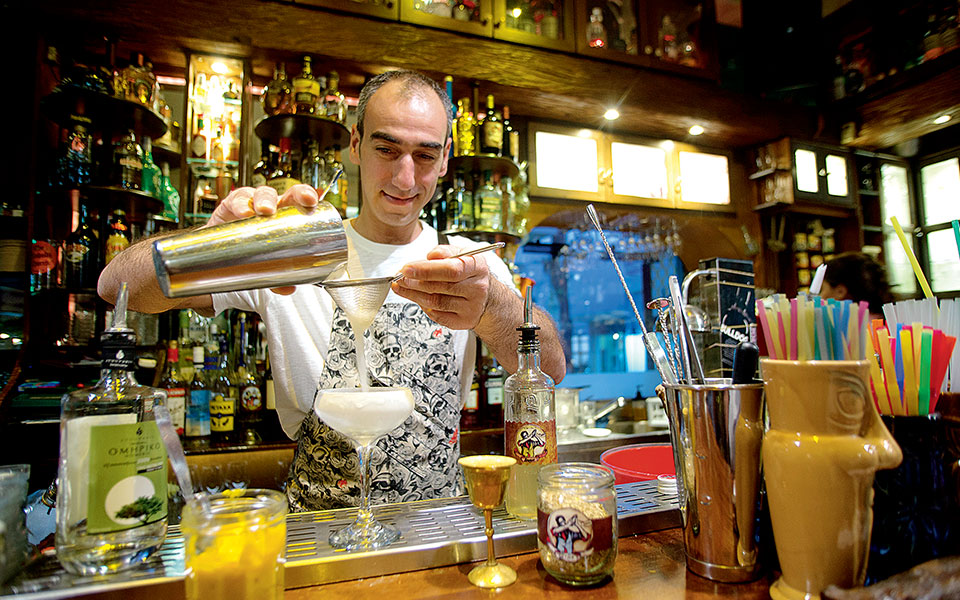
Aghios Bar - Paleochora
© Clairy Moustafellou
THE WITCH OF THE SOUTH: The sun, the sense of relaxation, the enchanting Libyan Sea, the feeling of freedom: it is for these reasons that people from all over the world have moved permanently to Paleochora. The small town with 1,500 inhabitants is built on a peninsula with two popular beaches within the settlement and many more further afield. Gialiskari (a sandy stretch) and Krios (a beach of fine shingle) are among the most impressive.
Inside the town, visit the small Venetian Fortezza and walk through the narrow lanes. Tavernas, small bars and shops add to its cosmopolitan aura. The best thing you can do is to spend the evening at Aghios Bar, in a space that housed a kafeneio since 1900. Jams, fruit purées, several types of eau de vie from herbs and fruits that they have distilled themselves are mixed with various kinds of aged raki, Greek wines and cognac to make unforgettable cocktails.
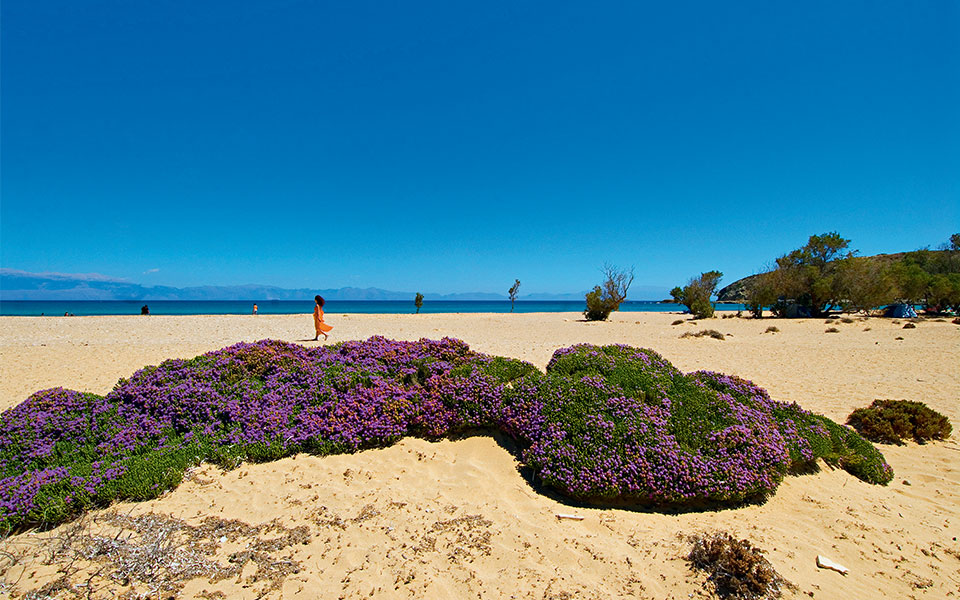
Sarakiniko beach - Gavdos
© Clairy Moustafellou
POSTCARD-WORTHY BEACHES: Crete’s western coastline is famous around the world for its sand dunes, turquoise waters, its mastic and arbutus trees, which offer precious shade, and its stunning sunsets. Balos is the star beach, more so perhaps because of the panorama that unfolds before your eyes as you walk the 20-minute path to get to it; there, you can see hundreds of people moving on the blindingly white sand like restive insects and Cape Tigani jutting out into the sea. You can also come here from the port of Kissamos by a caïque that also stops at the superb sandy beach of the uninhabited islet of Gramvousa, with its Venetian castle that is thought to be the first place in Crete to have been liberated from the Ottomans.
Further south, at Falasarna, the waters are light blue and crystalline, and the sand pink from thousands of seashells (please refrain from taking any as souvenirs, as their numbers are dwindling dangerously fast). It is relatively developed, with shops and rooms to let, and at its northernmost tip you can see the archaeological site of the ancient city of the same name which flourished in the 4th and 3rd centuries BC and was one of the most formidable naval powers of ancient Crete. Last but not least, the beautiful Elafonisi, at the southwestern tip of Crete, is a small island with sandy beaches, cedar trees and waters so shallow you can walk to it. A fragile, Natura 2000-protected ecosystem, it is currently under strain from the large numbers of people who flock here in the summer.
THE GOLDEN STEP: A little before Elafonisi you’ll come across Chrysoskalitissa Monastery, a beautiful complex with well-maintained gardens, built in the 19th century on the edge of a cliff. Climb the 98 steps, the last one of which, according to legend, was made of gold and had to be sold by the abbot during Ottoman rule in order to pay the land tax levied on non-Muslims. The view from the forecourt of the church is exquisite.
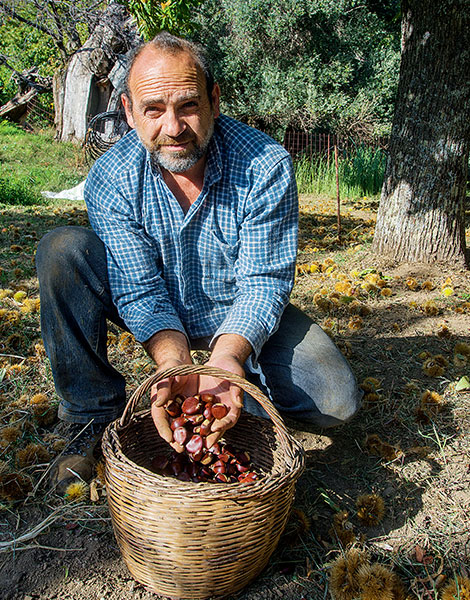
A chestnut farmer at Limni village
© Clairy Moustafellou
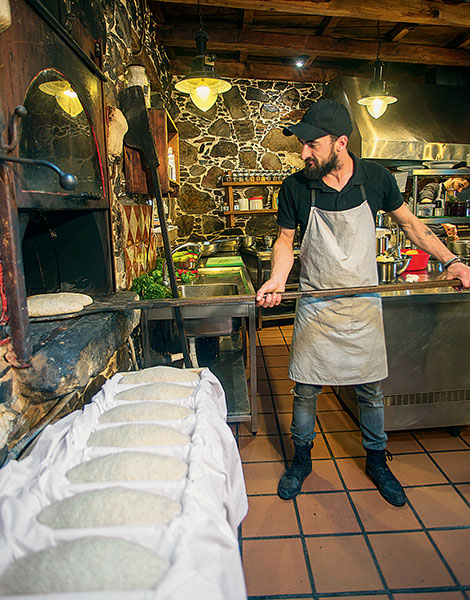
Milla village
© Clairy Moustafellou
CHESTNUT VILLAGES: Rising above the western coastline is the famous chestnut forest of Crete and the so-called Kastanochoria (“chestnut villages”). The local sweet chestnut, which the locals call maroni, became in times of hardship a basic food source for the villagers, who would grind it to a flour, and who still continue to cultivate it meticulously. During September and October, in the villages of Elos, Rogdia, Vlatos, Limni and others, you can see people collecting the fallen chestnuts to use for cooking, or to offer to guests raw or roasted, with or without an accompanying glass of raki. You can obtain them directly from the locals, or from the “9 Villages” (Ennia Horia) Development Company at Elos (Tel. (+30) 6959.400.237, (+30) 6974.405.586).
BACK TO BASICS: In 2009, National Geographic included Milia among the 50 best resorts with an ecological focus. Before that, the people who had revived this 17th-c. village by transforming it in its entirety into an agritourism resort had been looked upon as being out of their minds. They had reconstructed the stone-paved streets and rebuilt the old houses, taking care to change as little as possible and to use local craftsmen. Hidden in slopes that are verdant with chestnuts and oaks, on a site accessed by a dirt road from the village of Vlatos, Milia continues to be, since 1993, a real refuge.
During your stay you’ll learn about life in the village and the self-sufficiency that every household needed to have. Electricity is produced by solar energy, while the restaurant only uses candles at night. The tasty dishes are prepared strictly using fresh, local ingredients (as is breakfast); all vegetables, meat, wine and raki are the village’s own produce, while most dishes are cooked in a wood-fired oven. Events and cookery seminars are organized in the village’s facilities, while further afield there are nature activities that include visits to wineries, beekeepers and more (Reservations essential: Tel. (+30) 6945.753.743, www.milia.gr).
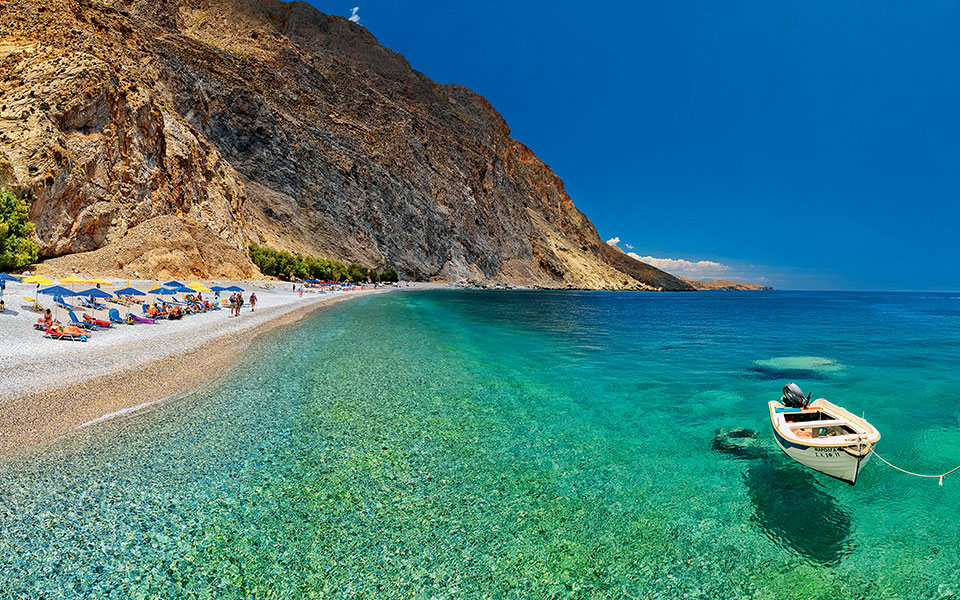
Glyka Nera beach
© Perikles Merakos
In this unique place of rough beauty, nothing is easy. It’s hard to reach and it’s hard to traverse. There are no roads – transportation is done mostly by boats. Nonetheless, you’ll fall for the place so hard that it will hurt to leave it.
Sfakia is its people. The men, described by the historian Vasilios Psilakis as “living statues of the gods” are generally tall, with blond hair and blue eyes. Back in the day, they wrapped black kerchiefs around their heads, wore black shirts and leather boots, carried guns in their pockets and age-old blood feuds and codes of honor in their hearts. Some still do. They’re unruly, rebellious descendants of the most renowned freedom fighters of Crete. The Sfakian women are known to be tough, proud and kind; they’ll invite you into their homes and feed you the traditional honey-drenched pies.
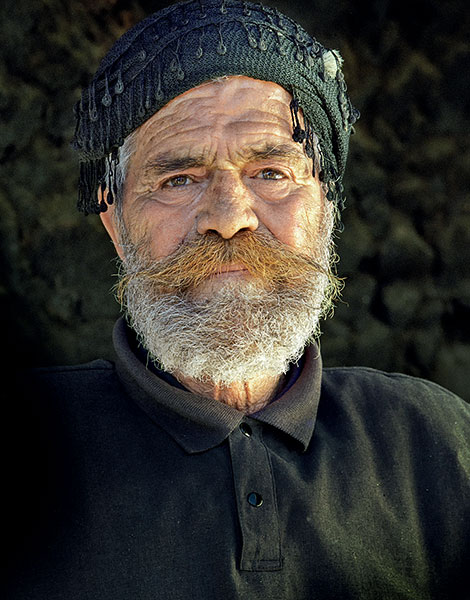
The late Yiannis Votzis, a proud Sfakian.
© Nikos Psilakis
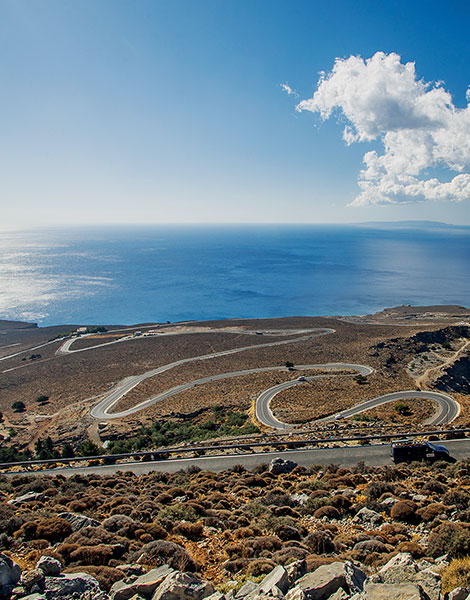
The long and winding road to Hora Sfakion
© Clairy Moustafellou
Sfakia is unreal. It has the Lefka Ori (White Mountains), with dozens of peaks over 2,000m and mountain plateaus where shepherds take their flocks in the summer and make the famous Sfakian graviera cheese from their milk in primitive rock dwellings. It has the eerie Mountain Desert with basins where hundreds of species of wild plants grow. There are the gorges, the deep scars that terminate in the Libyan Sea, such as Aradena, with its winding cobblestone passage and its bridge, a famous bungee jumping spot, and Samaria, the UNESCO-listed national park that attracts hiking enthusiasts from all over the world. There’s also a network of mountain paths connecting villages and beaches.
On the coast is Hora Sfakion, the area’s main town. Hop on one of the boats departing here for the village of Loutro, with its restaurants and tourist shops; for Marmara Beach, with its amazing sea caves and the famous Chrysostomos taverna, serving amazing food; and for Aghios Pavlos, a beach with pinetrees, a taverna and a charming 11th-c. chapel.
Aghia Roumeli Beach, at the end of the Samaria Gorge, is your reward for completing the 5-hour trek. Iligas, Glyka Nera, Foinikas, Likos, Domata and Trypiti are other beaches worth exploring, with varying degrees of seclusion.
Experience Crete’s slow food philosophy where...
Cretan cuisine lives on from home...
Swim in thermal springs, explore untouched...
A Polish-born artist who lives on...